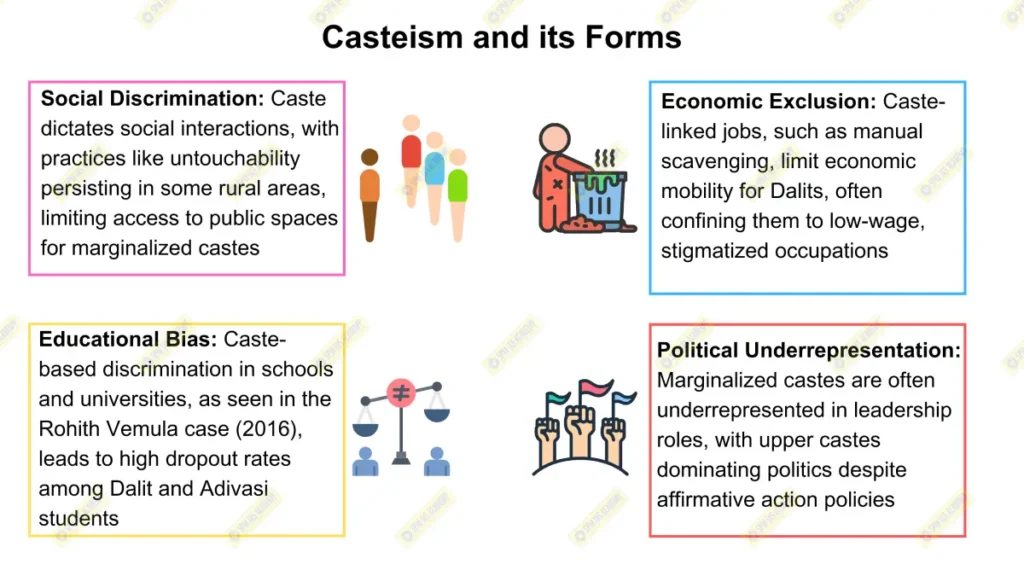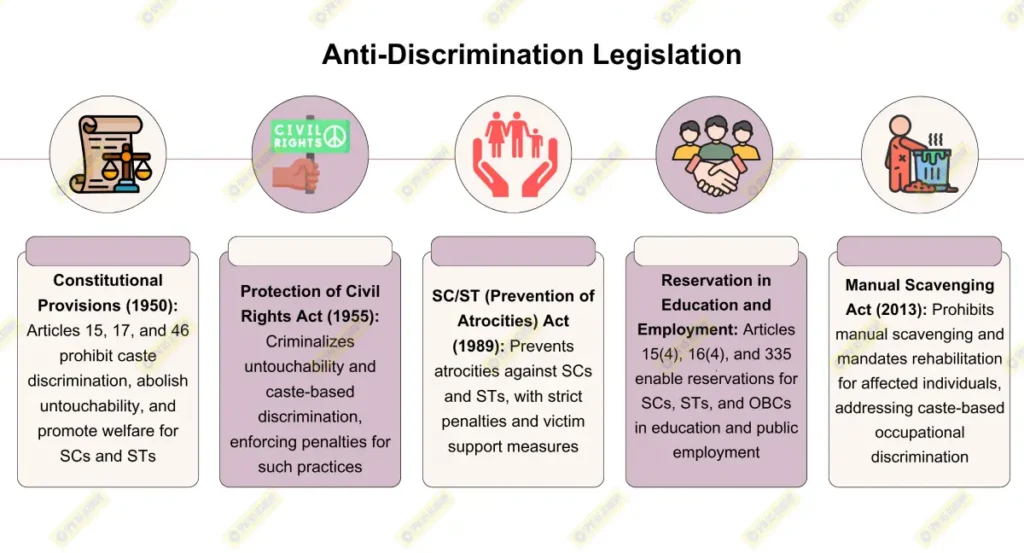Casteism remains one of India’s most deep-rooted social challenges, enduring despite numerous reform movements and legal measures aimed at its eradication. Historically embedded in Indian society, casteism affects socio-economic opportunities, access to education, political representation, and even social interactions. Despite legislative efforts such as the Protection of Civil Rights Act, 1955 and the Scheduled Castes and Scheduled Tribes (Prevention of Atrocities) Act, 1989, caste-based discrimination persists. As Dr. B.R. Ambedkar, a principal architect of the Indian Constitution and a crusader against casteism, said, “Caste is a notion; it is a state of mind,” underscoring the complex, ideological roots that sustain caste prejudice across generations.
Major Factors Responsible for the Persistence of Casteism in India
1. Historical and Cultural Entrenchment

The caste system, with origins in ancient texts, became socially entrenched over centuries, establishing a rigid hierarchy that dictated occupation, social interaction, and rights based on birth. Many communities still hold strong to traditional caste norms, creating a deep-seated bias. This persistence is often observed in rural areas, where caste-based segregation is still practiced in housing, education, and religious institutions, reflecting the continuity of ancient norms in contemporary society.

2. Socio-Economic Inequality and Lack of Mobility
Casteism is sustained by socio-economic disparities, where lower castes, especially Dalits and Adivasis, face limited access to quality education, health services, and economic opportunities. These inequalities perpetuate cycles of poverty and marginalization, making upward mobility difficult. For instance, despite affirmative action policies like reservation in educational institutions and government jobs, caste-based economic disparity remains a significant barrier to social equality. The inability to break these socio-economic divides reinforces caste distinctions and fuels prejudice.
3. Political Mobilization and Vote-Bank Politics
Caste affiliations have become a tool for political mobilization, with parties often appealing to specific caste groups to secure votes. This form of vote-bank politics reinforces caste identity, where political representation and benefits are promised based on caste affiliations. In states like Uttar Pradesh and Bihar, caste-based political alliances and campaigning are prominent, which strengthens caste loyalty and creates a vested interest in maintaining these divisions for electoral gain.
4. Social Segregation in Marriage and Community Life
Caste remains a significant factor in marriage and social interactions. The National Family Health Survey data shows that inter-caste marriages are still rare in India, with only about 5-10% of all marriages crossing caste boundaries. Social stigma and community pressure against inter-caste marriages often result in violence, including “honor” killings. This rigidity in marriage practices perpetuates caste purity and limits social integration, reinforcing the idea of caste boundaries.
5. Ineffective Enforcement of Anti-Caste Legislation
While India has robust laws against caste discrimination, such as the Scheduled Castes and Scheduled Tribes (Prevention of Atrocities) Act, 1989, their enforcement is often inadequate. Instances of atrocities against Dalits and marginalized groups still frequently occur, with limited legal recourse or delayed justice. For example, cases of caste-based violence or discrimination in rural India often go unreported or result in weak convictions, undermining the effectiveness of these laws. In many cases, social and political influences prevent proper investigation, creating a gap between legal intent and actual practice.
Way Forward
- Strengthen Legal Enforcement and Support Mechanisms: Ensuring stringent enforcement of anti-caste legislation, such as the Scheduled Castes and Scheduled Tribes (Prevention of Atrocities) Act, through dedicated fast-track courts, victim protection programs, and efficient grievance redressal systems can help in deterring caste-based discrimination. Regular monitoring and accountability at the local level can bridge the gap between legislation and implementation.
- Promote Social Awareness and Inclusivity: Comprehensive educational reforms and awareness campaigns that promote caste equality from a young age, along with encouraging inter-caste interactions and marriages, can help break down societal barriers. Community-driven initiatives and media can play a key role in reshaping public perception and promoting an inclusive mindset, thereby addressing casteism at its roots.
Despite the constitutional guarantees of equality and social justice, casteism persists due to deeply embedded cultural attitudes, socio-economic disparities, and political motivations. As Dr. Ambedkar’s quote highlights, casteism is not just a structural issue but a psychological one, necessitating a shift in societal attitudes and values. True social reform requires a multi-faceted approach that includes not only robust legal enforcement but also educational reforms, economic inclusion, and active efforts to dismantle caste identities. Only by addressing these complex, interconnected factors can India hope to move toward a more equitable and caste-free society.











